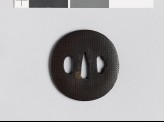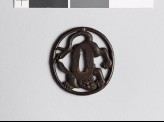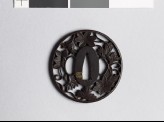The A. H. Church Collection of Japanese Sword-Guards (Tsuba)
An unpublished catalogue of the A. H. Church collection of Japanese sword-guards (tsuba) by Albert James Koop.
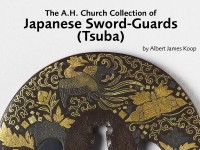
Okamoto Naoshige (also signing Tetsugendō, Toshiyuki, and Shōraku), an artist of Chōshū, came to Kiōto towards 1750 and studied under Tetsua Kuniharu of the Nara School, dying in 1780. His later signature, Shōraku, is found on most of the imitations of his work.
A common practice of the school generally is the writing of the signature wholly or partly in cursive, accompanied by a seal-mark (not kakihan) in gold inlay or nunome.
Naoshige worked chiefly on iron with figures in bold relief or in the round, enlivened by not too exuberant iroye incrustations and inlays after the Nara manner. A favourite motive is a thunder-storm, with little figures racing for shelter. His most famous pupil, Seiriūken Yeiju, who worked at Ōsaka, often did flat silhouette work in or or shakudō, enlivened by a certain amount of modelling and recalling Chōshū work.
 Tsuba in the form of two carp (EAX.11102)
Tsuba in the form of two carp (EAX.11102)
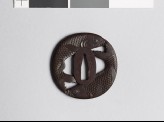 Tsuba in the form of two carp (EAX.11103)
Tsuba in the form of two carp (EAX.11103)
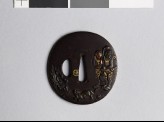 Lenticular tsuba with figures and a tiger in a landscape (EAX.11104)
Lenticular tsuba with figures and a tiger in a landscape (EAX.11104)
Notice
Object information may not accurately reflect the actual contents of the original publication, since our online objects contain current information held in our collections database. Click on 'buy this publication' to purchase printed versions of our online publications, where available, or contact the Jameel Study Centre to arrange access to books on our collections that are now out of print.
© 2013 University of Oxford - Ashmolean Museum

